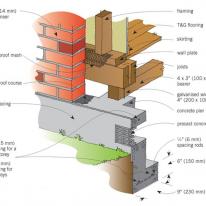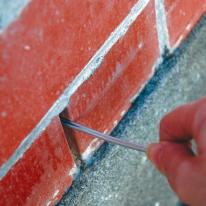Roof space dampness
An indicator may be water droplets on the underside of roof framing, roof underlay or roofing
Causes
Leaking pipes in the roof space
Moist subfloor air moving through brick veneer cavity where the cavity is open to the roof space
Kitchen and bathroom extractor fans discharging into the roof space
Header tank in the roof space has no lid
Moisture from the cavity of brick veneer-clad walls where the cavity is open to the roof space
Listed under: Interior, plumbing, pipes, mechanical ventilation, health and safety, Roof, Subfloor, roof space, moisture, condensation, leaks, mould, mould health and safety
Cause
A leak through roofing, around a chimney, flue or other roof penetration, from an inadequately flashed parapet or an overflowing internal gutter
Repair
-
identify and repair the leak(s). If the location of the leak is difficult to find, or there may be multiple leaks, call a registered building surveyor to investigate and recommend solutions
-
if the leak has resulted in bulk thermal insulation above the ceiling becoming saturated, the effectiveness of the insulation will be greatly reduced. Once the leak has been repaired, remove the wet insulation, allow the space to dry and replace with new insulation
Cause
Leaking pipes in the roof space
Repair
-
identify and repair the leak(s). If the location of the leak is difficult to find, call a licensed plumber to locate and make the repair
-
if the leak has resulted in bulk thermal insulation above the ceiling becoming saturated, the effectiveness of the insulation will be greatly reduced. Once the leak has been repaired, remove the wet insulation, allow the space to dry and replace with new insulation
Cause
Moist subfloor air moving through brick veneer cavity where the cavity is open to the roof space
Repair
-
block off the area at the bottom of the wall where subfloor air is moving into the brick veneer cavity (better to do this at the bottom of the wall than the top)
-
if the soil under the house is wet, see the repairs for Subfloor – damp soil
-
ensure good subfloor ventilation of not less than 3500 mm² of clear open subfloor venting for every 1 m² of floor area. Vents should be spread evenly around the building perimeter to allow cross-ventilation. No part of the subfloor should be more than 7.5 m from a ventilation opening
-
lay polythene sheeting at least 0.25 mm thick to completely cover the ground under the house. Ensure that the ground is shaped so no water accumulates on top of the polythene. Polythene sheets should be lapped a minimum of 150 mm, preferably taped, and butted up to foundation walls and piles. Weigh down the sheets with bricks or concrete to avoid them being displaced by air movement
Cause
Moist subfloor air moving through uninsulated framing space where holes were drilled in top and bottom plates to allow framing to dry when wet timber framing was used for construction
Repair
-
block off the area at the bottom of the wall where subfloor air is moving into the cavity if this is possible
-
if the soil under the house is wet, see the repairs for Subfloor – damp soil
-
ensure good subfloor ventilation of not less than 3500 mm² of clear open subfloor venting for every 1 m² of floor area. Vents should be spread evenly around the building perimeter to allow cross-ventilation. No part of the subfloor should be more than 7.5 m from a ventilation opening
-
lay polythene sheeting at least 0.25 mm thick to completely cover the ground under the house. Ensure that the ground is shaped so no water accumulates on top of the polythene. Polythene sheets should be lapped a minimum of 150 mm, preferably taped, and butted up to foundation walls and piles. Weigh down the sheets with bricks or concrete to avoid them being displaced by air movement
Cause
Moist air flow from kitchens and bathrooms into the roof space through wrongly installed ceiling vents or open recessed downlights
Repair
-
close off air flow routes between the rooms and the ceiling space. Replace ceiling vents with an extractor fan that discharges the moisture-laden air outside. In some cases the venting may be possible directly through a suitable point in an external wall. In many cases ducting must be installed to carry the exhaust air via the ceiling space to a roof or soffit vent
-
if there are older-style recessed downlights in the ceiling, these should be replaced with IC or IC-F labelled downlights which can be covered with insulation. An alternative is to fill the holes and install new fittings mounted on the ceiling
Cause
Kitchen and bathroom extractor fans discharging into the roof space
Repair
-
steam from a bathroom extractor fan or a kitchen rangehood should be vented to the outside. In some cases the venting may be possible directly through a suitable point in an external wall. In many cases ducting must be installed to carry the exhaust air via the ceiling space to a roof or soffit vent
-
locate the exhaust air outlet so the discharged air does not re-enter the home’s fresh air supply through a window or other passive ventilation route or active ventilation intake
-
prevent water entering the air outlet with proprietary louvres, automatic shutters or similar
Cause
Header tank in the roof space has no lid
Repair
-
provide a lid to the header tank and secure it so water does not slosh out in an earthquake
-
ensure at the same time that the tank is properly secured. There should be timber blocking (a minimum three blocks spaced as evenly as possible around the perimeter) to prevent sliding of the base of the tank sliding
-
the tank should be strapped (with 25 x 1 mm galvanised steel strap) to roof framing or braced to prevent it overturning.
Cause
Moisture from the cavity of brick veneer-clad walls where the cavity is open to the roof space
Repair
-
ensure drainage holes at the base of the brick veneer wall are clear to allow drainage and drying. There should be a drainage opening at every third vertical joint at the bottom course of veneer
-
ensure venting at the top of the walls is clear. Venting can be provided by:
-
a continuous 5 mm protected gap between the top of the veneer and the soffit lining
-
leaving every third vertical perpend open. (Locating the open perpends in the second to top course means the top course of bricks is less likely to come loose due to the missing vertical mortar)
-
if drainage holes and top vents are clear and there is still a problem, consult a registered building surveyor to investigate and make recommendations. In good brick veneer design the top of the cavity is not open to any soffit or roof space








